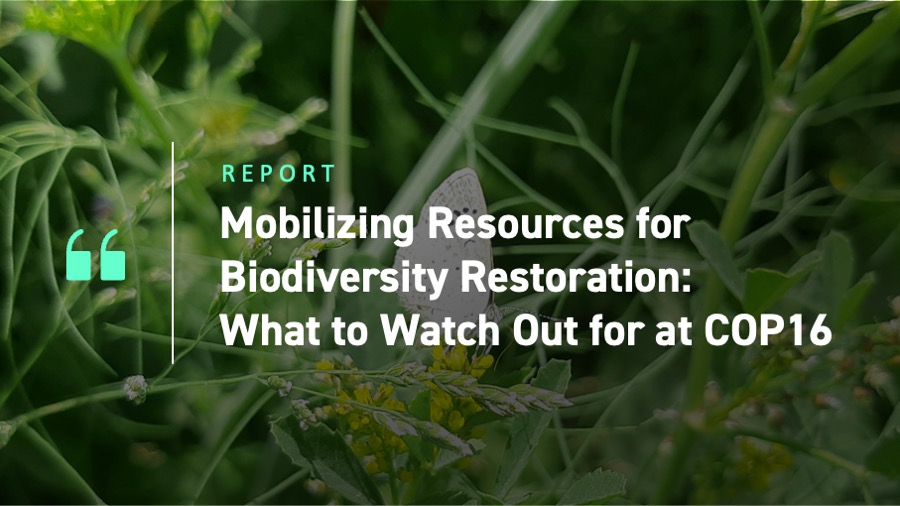The 16th Conference of the Parties (COP) to the Convention on Biological Diversity (CBD) is set to meet from 21 October – 1 November 2024 in Cali, Colombia. COP16 draws global attention to the urgent need for collaborative action to reverse biodiversity loss. The slogan of COP16, “Peace with Nature,” underscores the need for resilience “at a time when the world grapples with the triple planetary crisis of climate change, biodiversity loss and pollution.” For investors, COP16 could present an opportunity to reinforce commitments, build partnerships, and consider new investment opportunities for the restoration of natural ecosystems.
The Background and Significance of COP16
COP15, held in December 2022 in Montreal, produced the landmark Global Biodiversity Framework (GBF) agreement, signed by 196 countries, which set ambitious targets for biodiversity conservation through 2030 and beyond.
The outcomes of COP15 have provided a foundation for COP16, where the focus is now on implementation, by strengthening commitments at the national level, fostering collaboration, and introducing innovative solutions to address the biodiversity crisis.
Key Themes Expected at Cali
At COP 16, governments, NGOs, and the private sector are discussing and negotiating several agreements to help mobilize the resources needed to halt and reverse biodiversity loss. The biodiversity finance gap is estimated at more than $700 billion per year.
Key potential outcomes for COP16 include the following:
NBSAPs and Implementation Support: Revise, update, and adopt National Biodiversity Strategies and Action Plans (NBSAPs) at the country level, and more importantly, help secure resources needed to implement and monitor those plans, particularly in the Global South.
Resource Mobilization for Indigenous People and Local Communities: Secure adequate and accessible funding for Indigenous Peoples, local communities, and other rights-holders. Encourage processes to align public, private, and other financial flows for this end. Emphasize the inclusion of human rights-based approaches in decisions about accountability in nature-related investments.
Digital Sequence Information (DSI): Finalize a multilateral mechanism for the fair and equitable sharing of benefits derived from DSI. DSI on genetic resources emerged as a cross-cutting issue at the 2016 UN Biodiversity Conference. Access and benefit-sharing (ABS), addressed in Article 15 of the CBD and the Nagoya Protocol, will be featured on the agenda, and the conference will consider methods for the fair and equitable sharing of benefits from DSI on genetic resources, including a global fund.
Nature Positive: Reintroduce the concept of Nature positive, defined as ‘Halt and Reverse Nature Loss by 2030 on a 2020 baseline and achieve full recovery by 2050.’ A nature-positive approach emphasizes restoration and regeneration and involves activities that restore ecosystems, promote sustainable land use, and enhance the resilience of natural habitats.
Biodiversity Credits Standards: These standards aim to help the creation of a market for biodiversity credits, allowing businesses to invest in conservation projects as a way to offset their ecological impacts. This could lead to increased funding for restoration and sustainable practices. Biodiversity credits could be crucial in turning intentions into concrete actions, particularly if they can be integrated into national biodiversity strategies (and NBSAPs).
Climate and Nature Nexus: Pave the way to further integrate nature and climate actions at the upcoming climate and future biodiversity COPs.
Investor Actions
The financial community is expected to be present and active during the COP16 meetings, as many organizations have expressed interest in aligning their efforts with the GBF agenda. Specifically Target 19 of the GBF (out of the 23 targets) establishes a goal of securing $200 Billion per year from all sources, including $30 Billion through international finance resources.
UNEP has summarized several specific actions investors can take today to align their portfolios with GBF, such as building internal capacity to understand biodiversity across the organization, including the board of directors; screening and assessing biodiversity risk at the portfolio and issuer level; engaging with high-impact companies; and developing investment policies and strategies related to nature-loss impact drivers.
Conclusion
COP16 may be a significant juncture for global biodiversity. Amid growing challenges, the conference could provide an opportunity for investors to reinforce their biodiversity commitments, advance nature-positive initiatives, and help establish robust biodiversity credit standards. The outcomes of this gathering may influence the future of climate and nature action for years to come.
Explore ISS ESG solutions mentioned in this report:
- ISS ESG’s Biodiversity Impact Assessment Tool helps investors assess the impact of companies’ business and supply chain activities on biodiversity.
By:
Debaprasad Sengupta, Biodiversity Lead and Senior Associate, Natural Capital Research Institute, ISS ESG




